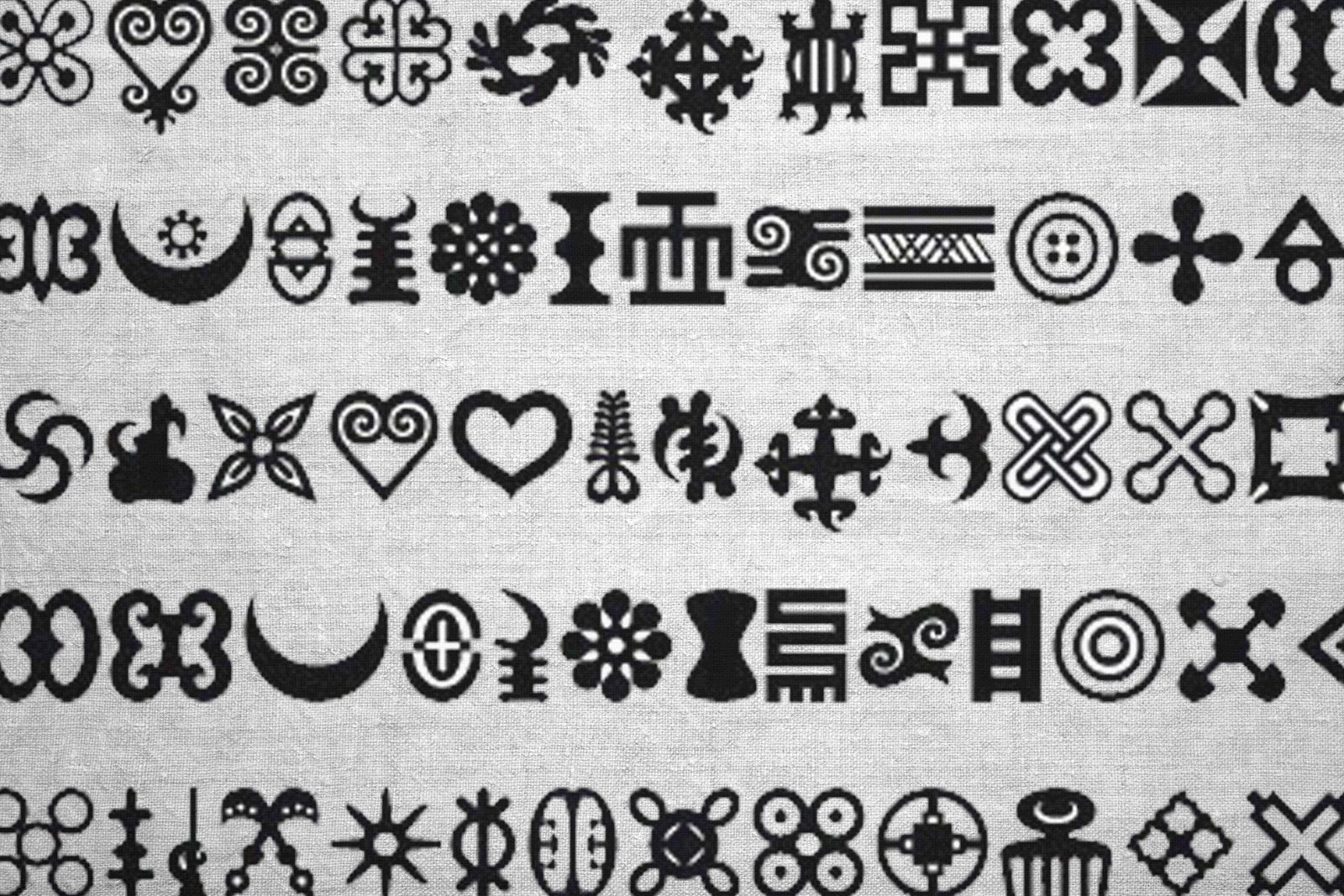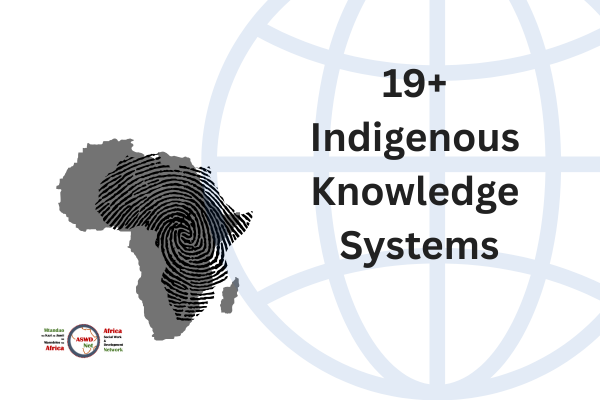
African symbols and their usefulness in social work and development
Recognising, valuing and using Adinkra symbols from west africa
- All Adinkra symbols on cloth
- All Adinkra symbols with their names
- Eighteen (18) signs for social work and development
- Sankofa
- World-wide usage
- How to use symbols in teaching and practice
- Kente design
- References
Like any other part of the world, Africa has symbols. These are physical (you can hold and see them), graphical (you can see them) or mind (you can visualise them) representations of African philosophy: knowledge, values, ethics, theories and practices. There are as many as 122 symbols in the Akan culture. Adinkra symbols were created to translate philosophy and African knowledge into tangible artifacts.
Generally, African symbols are versatile, are a tool for teaching and socialization into African ideals. Just like proverbs, symbols express African philosophy succinctly and non-verbally. Symbols preserve history and culture, and gives artists and scientists a foundation for their thinking. For children, symbols build their imagination, and incite them to be creative in a symbolic space that has meaning to them. Symbols, like proverbs, are multi-vocal, meaning they many have many related interpretations.
“Adinkra symbols embody Akan cultural values, which are built on the collectively-shared traditions of origins and social responsibilities (Anquandah, 2013). The imagery or memories of these traditions are usually retained in verbal forms such as myths, proverbs, oaths and witty sayings, and are used as ideal flash points to guide social actions and interactions (Sekyi-Baidoo, 1999: 124-125)”.
“Adinkra symbols are ideographical representations of proverbs, philosophies, thoughts, and values of the Akans of Ghana. The symbols encapsulate the worldviews and keen observations of human behaviour, and the interactions between nature and humanity” (Owusu, 2019). The symbols have “philosophical, educational, historical and moral values” (Kuwornu-Adjaottor Appiah and Nartey, 2015).
All Adinkra symbols on cloth
The nice printing is a result of the following process.
- Bark is taken from the badie tree – the trees grow in protected forests which are sacred. The trees are not cut to enable bark to grow again. Both sacredness and not cutting the trees is indigenous environmental protection knowledge.
- The bark is socked in water for days and then pointed when it gets softer.
- The pounded powder is boiled to produce die or ink, and the remains are fed back into the forest or land.
- Stamps that are made from calabash gourds or wood are dipped in the dye and patterned on cloth.
- Clothes can then be used to make dresses, shorts, t-shirts, shorts, head covers, bottom covers, ceremony apparel and many others.

Adinkra signs from Ghana Museum
All Adinkra symbols with their names

Eighteen (18) signs for social work and development
Below we have selected nine that relate to social work and development directly although all of them are relevant.

Sankofa
“Figuratively, sankofa, represents at least two closely related Akan maxims
that; ‘Se eto w’akyiri a fa, na sankɔfa, yenkyiri’, meaning ‘if it falls behind
you, retrieve it, for the recovery of that which was neglected is of a virtue’, and ‘Tete wo bi ka, tete wobi kyire, nti sankɔfa, yenkyiri’, meaning ‘the past has a lot to say, the past has a lot to teach, thus going back for something of the past is of a virtue” (Owusu, 2019).
Sankofa, a closer look
There are two symbols for sankofa.


Literal meaning: “Go back for it”.
Symbolic meaning: There is wisdom in learning from the past.
Background: This symbol shows the Akan’s admiration of their history. Akans believe that the way their ancestors and forefathers led their life is worthy of emulation and need continuity so if the current generation will admit this fact and go back to their roots for the good things their ancestors did to succeed in life, it will help them a lot. The philosophy behind the Akans trust in the aged as consultants of wisdom is found in many Akan proverbs and folktales. Philosophical lesson: the symbol teaches the wisdom in learning from the past to help improve the future. It also teaches people to cherish and value their culture and avoid its negative adulteration. This is the symbol of positive reversion and revival.
Application to contemporary living: Sometimes people frown, ignore and neglect their cultural heritage. These traditions have been abandoned for foreign cultures due to the stigma attached to them. Some people however, have recognized the importance of taking up relevant cultural values useful for contemporary living. It is believed that progress is based on the right application of positive aspects of the past values. Most of the basic schools in Ghana beat traditional drums to pass information to the pupils, also some people are calling for reinstatement of puberty rite (a traditional rite which was performed in the past to usher a girl into adulthood). During state functions, Traditional Priests are often invited to pray for the state (Kuwornu-Adjaottor Appiah and Nartey, 2015).
“The allusion to Sankofa is therefore a call to reflect on some relevant aspects of the past (perhaps neglected) and rejuvenate them for both contemporary life and the future” (Owusu, 2019).
World-wide usage
The symbols from the Akan alphabet have been used as logos or names of individuals or organisations and companies several times throughout Africa and the world. The arf found on clothing. They have been used in Christianity to represent oneness of God, diversity, respect and leadership (Ossom-Batsa and Apaah, 2018). You find them on Christian ornaments, garments and other tools of worship.
There was an attempt to replace all these symbols with those from Abrahamaic religions, for example, the cross but African symbolism survived.
How to use symbols in teaching and practice
They are new in social work but they are finding their way in. It is our role to ensure we value and use them.
- Create a story that shows the meaning of each symbol.
- Ask students to pick symbols that show values and ethics in social work.
- Ask students to link each symbol to Africa’s philosophy.
- Display the symbols at home, work and classroom to communicate their values.
- Use them to teach about African religion and spirituality.
- Refer to them in code of ethics.
- Use them as user names or pass words.
- Use Adinkra stamps for art.
- Use Adinkra signs to teach about protecting the environment.
- Use Adinkra signs to teach about socio-economic development.
- Use the signs in design of buildings, bricks and blocks.
- Teach students to make Adinkra signs so that they could transfer the skills to communities.
- Invite a person who knows about the signs to explain their meanings, a cultural expert for example.
Kente design
From the Akan also comes Kente design which usually appears on handwoven and decorated cloth. A future blog will cover Kente. The picture below which has been part of our homepage since the website was created, is a Kente piece, as well as the second one.


References
Owusu, P. (2019). Adinkra Symbols as “Multivocal” Pedagogical/Socialization ToolContemporary. Journal of African Studies 2019; 6 (1): 46-58.
Ossom-Batsa, G. and Apaah, F. (2018), Rethinking the Great Commission: Incorporation of Akan Indigenous Symbols into Christian Worship. International Review of Mission, 107: 261-278. https://doi.org/10.1111/irom.12221
Kuwornu-Adjaottor JET, Appiah Gand Nartey M (2015). The philosophy behind some Adinkra symbols and their communicative values in Akan. Philosophical Papers and Review, 7(2), 22-23.
Use the form below to subscibe to Owia Bulletin.
Discover more from Africa Social Work & Development Network | Mtandao waKazi zaJamii naMaendeleo waAfrika
Subscribe to get the latest posts sent to your email.




I’m glad we have a medium on wish we can develope ideas and blueprints for social emancipation of Africa. Thank you to the initiator of this idea. I’m happy to be a member of this team.